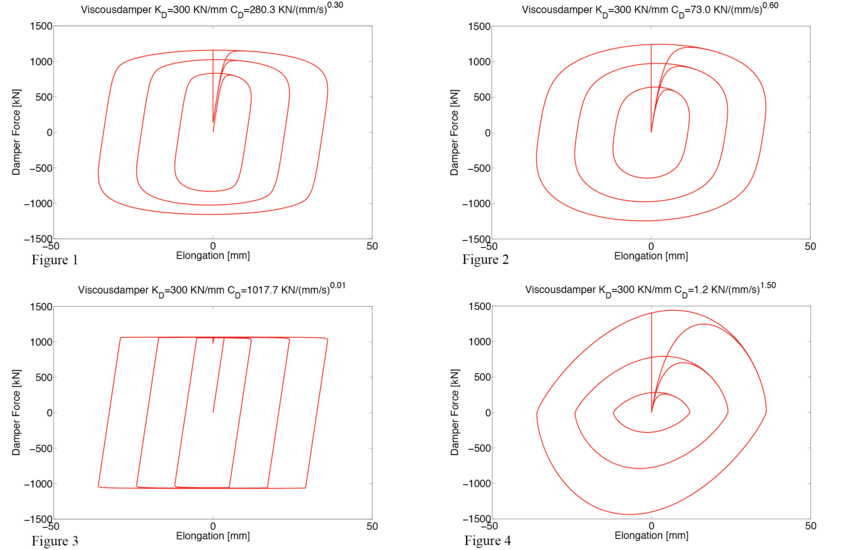ViscousDamper Material: Difference between revisions
Jump to navigation
Jump to search
No edit summary |
No edit summary |
||
| Line 4: | Line 4: | ||
{| | {| | ||
| style="background:lime; color:black; width:800px" | '''uniaxialMaterial ViscousDamper $matTag $K $Cd $alpha <$LGap $NM $RelTol $AbsTol $MaxHalf> ''' | | style="background:lime; color:black; width:800px" | '''uniaxialMaterial ViscousDamper $matTag $K $Cd $alpha <$LGap> < $NM $RelTol $AbsTol $MaxHalf> ''' | ||
|} | |} | ||
| Line 20: | Line 20: | ||
| '''$LGap ''' || gap length to simulate the gap length due to the pin tolerance | | '''$LGap ''' || gap length to simulate the gap length due to the pin tolerance | ||
|- | |- | ||
| '''$NM ''' || | | '''$NM ''' || Employed adaptive numerical algorithm (default value NM = 1; 1 = Dormand-Prince54, 2=6th order Adams-Bashforth-Moulton, 3=modified Rosenbrock Triple) | ||
|- | |- | ||
| '''$RelTol ''' || Tolerance for relative error control of the adaptive iterative algorithm (default value 10^-6) | | '''$RelTol ''' || Tolerance for absolute relative error control of the adaptive iterative algorithm (default value 10^-6) | ||
|- | |- | ||
| '''$AbsTol ''' || Tolerance for absolute | | '''$AbsTol ''' || Tolerance for absolute error control of adaptive iterative algorithm (default value 10^-6) | ||
|- | |- | ||
| '''$MaxHalf ''' || Maximum number of sub-step iterations within an integration step (default value 15) | | '''$MaxHalf ''' || Maximum number of sub-step iterations within an integration step (default value 15) | ||
Revision as of 10:47, 17 May 2015
- Command_Manual
- Tcl Commands
- Modeling_Commands
- model
- uniaxialMaterial
- ndMaterial
- frictionModel
- section
- geometricTransf
- element
- node
- sp commands
- mp commands
- timeSeries
- pattern
- mass
- block commands
- region
- rayleigh
- Analysis Commands
- Output Commands
- Misc Commands
- DataBase Commands
This command is used to construct a ViscousDamper material, which represents the Maxwell Model (linear spring and nonlinear dashpot in series). The ViscousDamper material simulates the hysteretic response of nonlinear viscous dampers. An adaptive iterative algorithm has been implemented and validated to solve numerically the constitutive equations within a nonlinear viscous damper with a high-precision accuracy.
| uniaxialMaterial ViscousDamper $matTag $K $Cd $alpha <$LGap> < $NM $RelTol $AbsTol $MaxHalf> |
| $matTag | integer tag identifying material |
| $K | Elastic stiffness of linear spring (to model the axial flexibility of a viscous damper (brace and damper portion) |
| $Cd | Viscous parameter of damper |
| $alpha | Viscous damper exponent |
| $LGap | gap length to simulate the gap length due to the pin tolerance |
| $NM | Employed adaptive numerical algorithm (default value NM = 1; 1 = Dormand-Prince54, 2=6th order Adams-Bashforth-Moulton, 3=modified Rosenbrock Triple) |
| $RelTol | Tolerance for absolute relative error control of the adaptive iterative algorithm (default value 10^-6) |
| $AbsTol | Tolerance for absolute error control of adaptive iterative algorithm (default value 10^-6) |
| $MaxHalf | Maximum number of sub-step iterations within an integration step (default value 15) |
Examples:
| 1. Input parameters: |
| Assume a viscous damper with axial stiffness K=300.0kN/mm, viscous parameter Cd=280.3kN(s/mm)0.3, and exponent a=0.30. |
| The input parameters for the material should be as follows: |
| uniaxialMaterial ViscousDamper 1 300 280.3 0.30 |
| Using these properties, Figure 1 shows the hysteretic response of this damper for sinusoidal displacement increments of 12, 24 and 36mm and a frequency f = 0.5Hz. |
| The sensitivity of the viscous damper with respect to its axial stiffness is shown in Figures 2 to 4 for the following set of parameters: |
 |
| 2. Single story single bay frame with viscous damper |
References:
| [1] | Akcelyan, S., and Lignos, D.G. (2015), “Adaptive Numerical Method Algorithms for Nonlinear Viscous and Bilinear Oil Damper Models Under Random Vibrations”, ASCE Journal of Engineering Mechanics, (under review). |
| [2] | Oohara, K., and Kasai, K. (2002), “Time-History Analysis Models for Nonlinear Viscous Dampers”, Proc. Structural Engineers World Congress (SEWC), Yokohama, JAPAN, CD-ROM, T2-2-b-3 (in Japanese). |
| [3] | Kasai K, Oohara K. “Algorithm and Computer Code To Simulate Response of Nonlinear Viscous Damper” Passively Controlled Structure Symposium 2001, Yokohama, Japan (in Japanese). |
Code Developed and Implemented by : Sarven Akcelyan & Prof. Dimitrios G. Lignos, (McGill University)